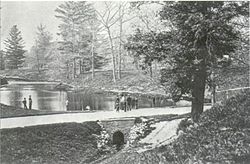| Taddle Creek | |
|---|---|
 Taddle Creek, dammed to create McCaul's Pond, on the University of Toronto campus in 1870 | |
 | |
| Location | |
| Country | Canada |
| State | Ontario |
| City | Toronto |
| Physical characteristics | |
| Source | |
| • location | Bathurst Street and St. Clair Avenue West, Toronto, Ontario, Canada |
| Mouth | |
• location | Lake Ontario, just east of Parliament Street, Toronto, Ontario, Canada |
| Length | 6 km (3.7 mi) |
Taddle Creek is a buried stream in Toronto, Ontario, Canada that flowed a southeasterly course about six kilometres long, from St. Clair Avenue west of Bathurst Street through the present site of Wychwood Park, through the University of Toronto, into the Toronto Harbour near the Distillery District. [1] During the 19th century, it was buried and converted into an underground sewer, but traces of the creek can still be found today. The scenic footpath known as Philosopher's Walk follows the ravine created by the creek from the Royal Ontario Museum to Trinity College. Taddle Creek is also the name of a Toronto literary magazine and of a local Montessori school. [2]
